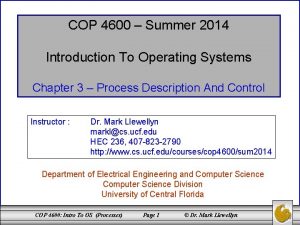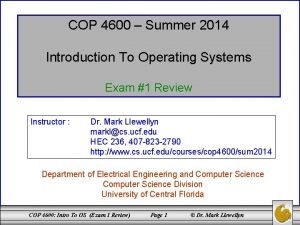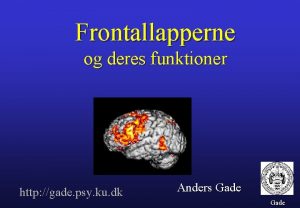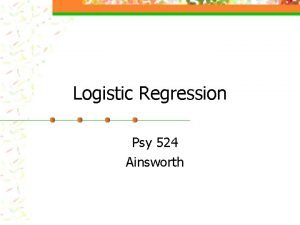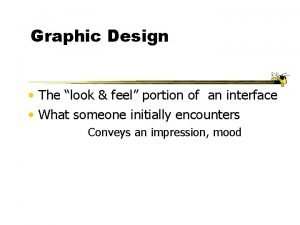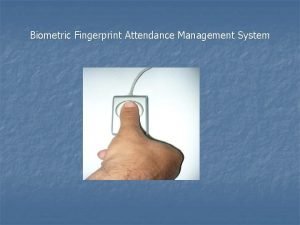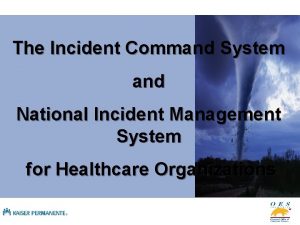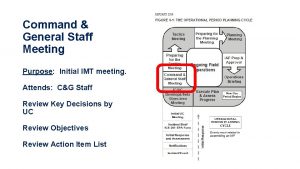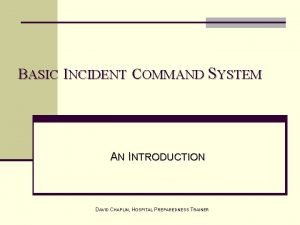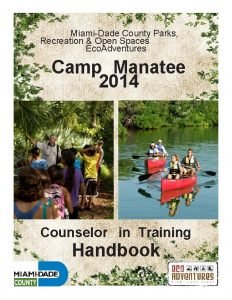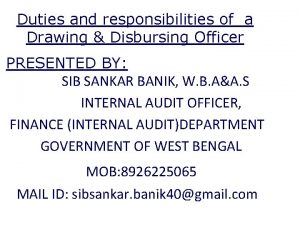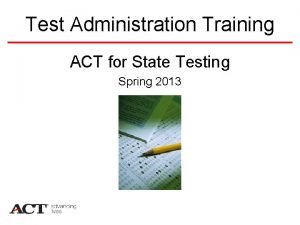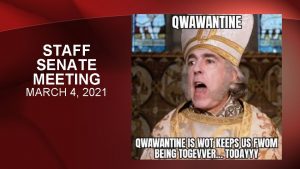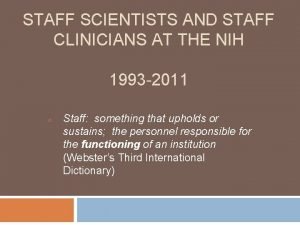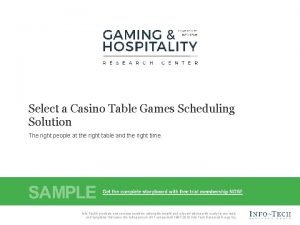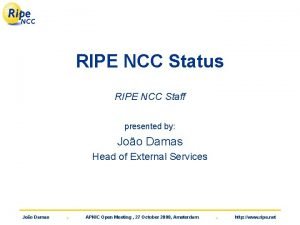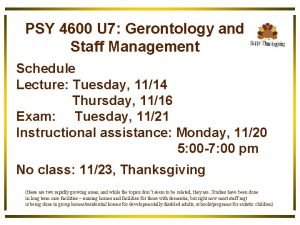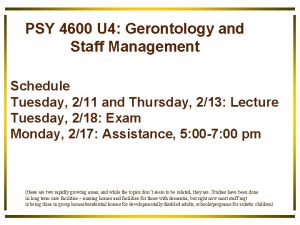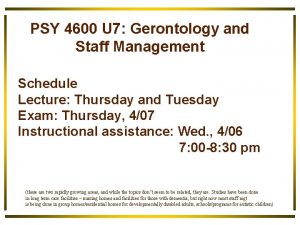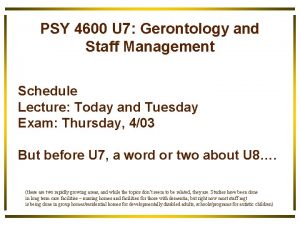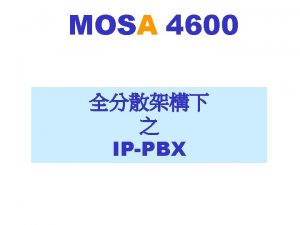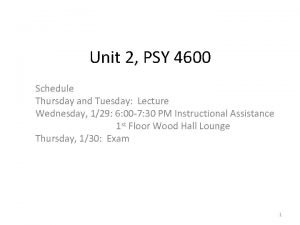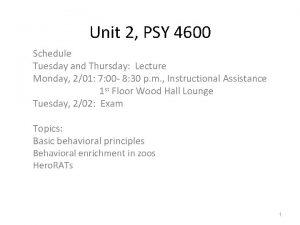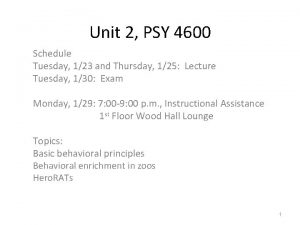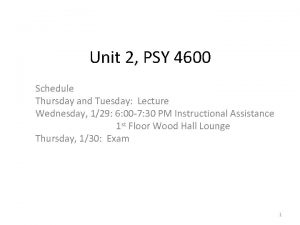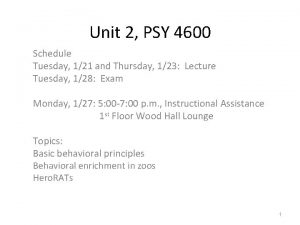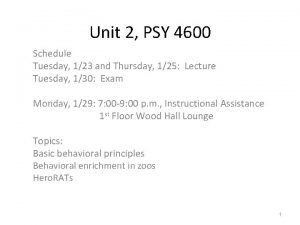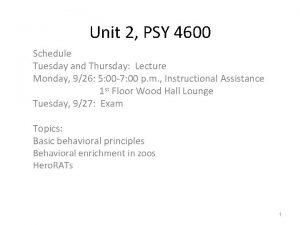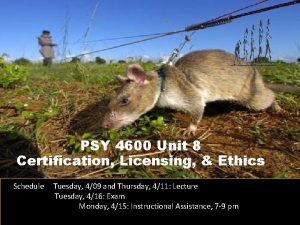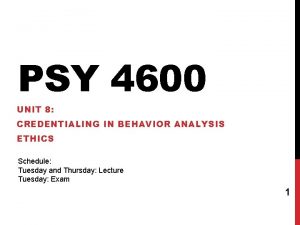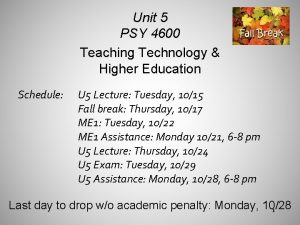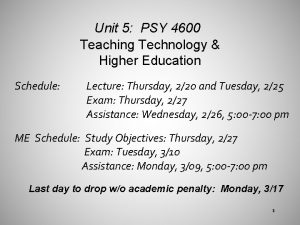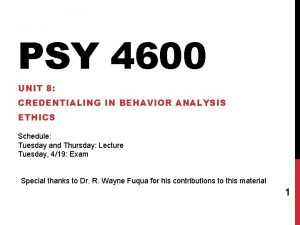PSY 4600 U 7 Gerontology and Staff Management







































































- Slides: 71

PSY 4600 U 7: Gerontology and Staff Management Schedule Lecture: Thursday, 3/30 Tuesday, 4/04 Exam: Thursday, 4/06 Instructional assistance: Wednesday, 4/05 6: 00 -7: 30 pm (these are two rapidly growing areas, and while the topics don’t seem to be related, they are. Studies have been done in long term care facilities – nursing homes and facilities for those with dementia; but right now most staff mgt is being done in group homes/residential homes for developmentally disabled adults, schools/programs for autistic children)

Gerontology • Behavioral gerontology is a growing field • There are not many Ph. D. level behavioral gerontologists in the world • Obviously, as the upcoming slides will point out we need more!

Gerontology: Expanded Services • More living options for seniors – In-home with assistance (daily living tasks) – Retirement communities with many different options and continuous care – Assisted living communities that specialize in dementia (these are not nursing homes or retirement communities) • WMU’s Center for Disability Services – Care management • Assessment and recommended options for care needs – Senior day programs – Supported living in-home, personal care – Respite care for caregivers

Gerontology: Expanded Services • Hospital-based medical in-home care • Commercial in-home service agencies • WMU’s Center for Gerontology at WMU – Minor in gerontology – Graduate certificate (fall 2015), 15 hours, online courses • Behavioral Gerontology SIG affiliated with ABAI: Great resource! – bgsig. wordpress. com • Provides publications in the area, 1975 -2016 • Provides recent presentations and posters • Provides a list of universities and professors providing training in this area • Provides employment and postdoc opportunities!

SO 1: Aging of America • The proportion of the population over age 65 in the U. S. increased from 4% to 13% in the 20 th Century • It is predicted to be 20% of the population by 2030 5

SO 2: Aging of America, Contributing Factors • Medical advances increased life expectancy about 30 years between 1900 & 2000 • Aging of Baby Boomers • Born during the post-World War II baby boom • Years between 1946 and about 1953 6

SO 3: Effects of Aging Living longer means a substantial portion of elders live with chronic illness and disability – Higher total cost of care – Greater care needs – Potentially lower quality of life (more doctor’s visits, more medication, more MRIs, , more protthestics - hearing aids, walkers, etc. ) 7

Behavioral Gerontology • Application of behavioral principles to aging issues – Clinical/Rehabilitation Issues – OBM/Staff Training Issues • Different approach to aging from typical medical model of inevitable biological decline (Just because you lost it, doesn’t mean you can’t get it back; provide behavioral/environmental supports; teach people how to self-prompt) 8

SO 4: Behavioral Gerontology • From a behavioral perspective, when a person ages (examples of each follow) – Fewer discriminative stimuli control behavior – Different motivating operations are likely – Contingencies of reinforcement tend to support the wrong behaviors (Go back and look at examples of each) 9

SO 4: SDs become less effective • Get lost when driving to someplace you go to frequently (i. e. , the grocery store) and don’t know how to get home • Faces may no longer evoke correct names - even of loved ones • Trouble with ordinary conversations; words don’t evoke typical responses, particularly with a quick change of topics • Can’t write a check anymore, and certainly cannot master web banking (how do you pay bills? ) • TV/DVD/TIVO remotes: two or more remotes, each one is different (stimulus control combined with punishment), can’t figure out how to do things • Changing technology – phones used to be easy; using menus and navi keys are 2 nd nature to you – not to seniors; too many buttons, too many options! 10

Stimulus Control & Punishment Great Call Jitterbug phone: Great for seniors! (buttons are all in different places, symbols v. words, not one but two navi pads, jitterbugs) 11

SO 4: Different MOs • Deprivation of social contacts makes elders susceptible to telephone solicitors and scams by strangers (someone calls – they end up buying the product; someone comes to the door - they let them in) • Foot pain, hip replacement, arthritic pain make a decrease in pain reinforcing and evoke behaviors that lead to decreased pain – inactivity, watching TV, etc. win out over activities such as gardening, walking in the woods, needlepoint (also pain punishes those behaviors if engaged in) • Sleep deprivation is often present so evokes more irritable behaviors (when cut off when driving, or a relative is late for a visit, or a grandchild begins to cry/scream) Fact that not only quantity but quality of sleep changes with age 12

SO 4: Reinforcement for dependent behaviors and punishment for active behavior • When do you go see Grandma? When she is not feeling well. (reinforcement for complaining and behaviors related to not feeling well) • Punishment for verbal behavior when can’t “find the right word” or “follow the conversation” • “Does it hurt to do that? Why don’t you rest and let me do it? ” (reinforcement for dependent behaviors) • “Let me go to the grocery store for you” (same issue as with Fordyce, chronic pain) 13

Behavioral Gerontology • Use of behavioral procedures to solve problems related to SDs, MOs, and wrong reinforcement/punishment contingencies – No different than the approach we take in other areas of specialization 14

Enjoy Old Age, 1983 (click, animation) 15

SO 5: Why behavioral gerontology is needed • The major cause of caregiver stress and the most common cause of institutionalization are – Behavior problems – Not medical problems and health declines • 65% of individuals in nursing homes have significant behavior problems • Can lead to high staff turnover (I can’t take it anymore on the part of the caregiver due to aggression, arguing, losing things, wandering; too vague for the Exam – could refer to medical problems as well as behavioral problems) 16

NFE: Obstacles to widespread behavioral services • Practitioners are reluctant to serve elders – no training – Because of that it is hard to locate behavioral services • Older people and caregivers perceive stigma for accessing mental health services – Older adult: means “I’m crazy” – Caregiver: “a good son/daughter/wife/husband” could handle it without help (Cont. on next slide) 17

Obstacles, cont. • Medical Model Myths – Medications/drugs are the only thing that will work most common intervention – Once a skill is lost it cannot be regained • Cost and effort constraints – Simple and/or cheap will always be selected Which is simpler and less effortful? Medication or behavioral interventions? Elders are taking an average of 5 different meds 18

SO 6: NFE: Anxiety and Depression • Anxiety and depression are not common in seniors, contrary to popular belief • Anxiety: – Only about 6% of healthy elders have clinical anxiety – Higher rates in elders with medical conditions • Depression – Only occurs in 2 - 10% of older adults – 2 x more in women (as in younger population) – 40 -50% of people in nursing/retirement homes • Which comes first, the chicken or the egg? 19

Behaviorally. . why depression/anxiety? – Loss of reinforcers due to changes in the environment • Including deaths of siblings, friends, and perhaps life mate – Loss of reinforcers due to physical deterioration of receptors • can’t hear or see as well • aren’t as strong • have trouble opening containers – Increased dependence but don’t want to be a burden • can’t drive anymore (can’t go shopping when you want to) – But remember, healthy seniors are not depressed or anxious • Economically stable (hopefully) • Tend to become more “forgiving” and “kinder” • Not as concerned about what other people think 20

Behavioral Gerontology Services • Typical Nursing Home – No active engagement, even in leisure activities – No social interaction or conversations – Memory problems – High rates of problem behavior Behavioral gerontologists have tackled each of these problems successfully 21

SO 7: Aggression • 85% of seniors with dementia physically aggress their care providers – This is one of the most common behavioral problems that leads to placement in long-term care facilities, physical constraints, and/or medication • 75% of the aggressive behaviors have been shown to be escape behaviors from antecedent task demands (MOs) related to daily living activities – Dressing, taking the senior to the bathroom, showering/bathing, brushing teeth, shaving, etc. (moderate to severe) – Antecedent MOs include verbal prompts, physical prompts, task demands: it’s time to get up, you need a bath/shower, put on your out-door clothes, why don’t you take a walk, you shouldn’t be drinking that glass of wine (mild to moderate) • NAG, NAG all day long! 22

SO 7: Aggression • Common behavioral interventions: – Care provider moves away and stops the demands • Often done to prevent the senior from “being too upset” • Care provider doesn’t want to be hurt – Time out (a punishment procedure) What’s wrong with these interventions? ? (answer, next slide) 23

SO 7: Aggression What’s wrong with these interventions? ? MO: R Task demands, prompts demands Aggression Sr. No task In words: These interventions terminate the task demands, which negatively reinforces the aggression (This is why functional assessment, determining the cause of the behavior is so important before designing an intervention ) 24

SO 7: NFE, What to do instead? • Noncontingent escape – Determine interresponse time of aggression • Seconds before onset, seconds in-between – Provide escape (terminate the activity or prompt) before aggression occurs • Form of differential reinforcement Example: Elder in a nursing home aggressed against care givers during toileting. Found it was escape-maintained. It started ~30 s after toileting began, and thereafter every 25 s. Care givers prompted toileting, but stopped after 20 s, paused for 10 s, then began prompts again. Repeated this until end of toileting. Aggression decreased to near 0 levels. (Study by Dr. Jon Baker: extinction next) 26

SO 7: NFE What to do instead? • Extinction is also possible if the senior will not hurt himself/herself or the care giver – There is, of course, concern about an extinction burst • Seems “cruel” but – Literature suggests that alternatives have been punishment or high doses of medication • Physical restraints • Strong verbal reprimands (How would you extinguish? Are these kinder? Drugs do decrease aggression, but are systemic and decrease the entire activity level of the elder. Do you want a doped up Grandpa? ) 26

SO 8: Bourgeois (1993), Memory Wallets • Effects of memory aids (wallet) on conversations of individuals with dementia • People with dementia appear incoherent in conversation because they (mainly intraverbals) – Substitute vague words for specifics – Don’t follow the content or topic – Cannot spontaneously generate topics • Interventions like memory wallets do result in better conversations (really like this, simple intervention; if you ask them what they did that morning, they may start complaining about the food at dinner or staff , or talk about an event that was a very long time ago) 27

My Nieces: Caroline, Courtney, Jessica 28

My favorite color is blue. My cat is Mr. Snuffles and he is a Siamese. 29

I live at 427 Bloomfield Ave 30

Bourgeois (1993) Memory Wallets • Participants: 6 individuals at adult day care centers • Two individuals talk to each other • Memory wallet for one of the two was used – Interviewed family members to develop list of facts and topics – Took corresponding pictures to include in wallet • 5 minute conversations 3 times per week • Measured – Statements related to the memory aid – On-topic statements 31

SO 8: Bourgeois (1993) Memory Wallets • Research design – Reversal: BAB • Results (exception one P, most demented) – Quite a few statements directly related to the aids – More on-topic statements about the aids, but also about other areas (generalized to other topics) – More on-topic statements by the partner - it wasn’t their aid! • Social Validity – 13 Speech Staff listened to tapes and rated quality – Aided conversations rated higher on staying on topic, being less ambiguous, and in general, just being more 32 comfortable to listen to,

No Aid Memory Aid 33

SO 9 Intro (NFE): The Intersection of Gerontology and OBM/Staff Mgt • It’s important for behavior analysts to develop and experimentally evaluate interventions to deal with problem behaviors • However, we need care givers and staff to implement those interventions • This is where OBM/Staff Mgt comes in (OBM in business and industry, but typically staff mgt in human services) 34

Gerontology and OBM/Staff Mgt • Direct care staff in nursing homes – Are CNAs (Certified Nursing Assistants) – Often receive low pay and work long hours – Have many potentially unpleasant aspects to their job – Are often kind people who sincerely want to help – Often have no idea that their actions are directly contributing to an environment that • Suppresses independence and activity • Reinforces problem behavior (note medical model, nursing, rather than hiring direct care staff with behavioral background – different than in group homes and residential facilities for DD and autistic children supervisors have a psychology/behavioral background) 35

Gerontology and Staff Mgt • Staff training and performance monitoring are a critical part of providing good care in nursing home settings • Staff will often acquire knowledge of procedures in in-service then fail to use the procedures when they interact with clients – No system in place to make it worthwhile or feasible to maintain new procedures 36

SO 9: Engelman, Altus & Mathews (1999), Increasing Leisure Activities • Designed to increase engagement in leisure activities • Engagement in leisure activities is believed to: – Increase the quality of life of individuals by bringing them into contact with reinforcers they enjoy – Decrease inappropriate behaviors • Often, however, elders with dementia don’t initiate activities without assistance • While staff are encouraged to facilitate this, they are not trained to help them choose or maintain leisure activities • Furthermore, staff have a lot to do and may have many competing job responsibilities (Basically, just make them happier; True of other at-risk populations as well, DD) 37

SO 9: Engelman, Altus & Mathews (1999) • 5 residents in a nursing home with dementia • Intervention: – CNAs were trained to • Check-in with each of their assigned residents every 15 min • If engaged, praise activity • If not engaged, offer activity choices and assist if necessary – CNAs were observed and given written performance feedback • Measured appropriate engagement, inappropriate engagement, no engagement of residents • Research Design = MB across morning/afternoon (really cool design) 38

39

40

41

Engelman, Altus & Mathews (1999) • Results – All participants experienced increased appropriate engagement • over 80% of intervals in morning • over 70% of intervals in afternoon – MB design clearly shows the increase was due to the check-in procedure – Greater diversity of activities • 7 in baseline, over 20 in intervention (Piano player; sometimes the problem is they just can’t get started by themselves) 43

SO 10: Engelman et al. (2003), Increasing independence • Well meaning staff may increase resident dependence by doing everything for them • System of “Least to Most” Prompts ensures opportunity to perform independently – Verbal (least help/prompt, fosters most independence) – Gestural (next level of help/prompt, independence) – Physical (most help/prompt, fosters least independence) • Intervention – Interactive 30 min training on System of Least to Most Prompts (model, rehearse, feedback) – Feedback: Daily monitoring of consumer performance by CNA 43

SO 10: Engelman et al. (2003), Increasing Independence • Participants: 2 CNAs; 3 elders with dementia • Measured – CNA use of Least to Most Prompts – Time it took to dress elders • Research Design = MB across elders • Results – Prompts increased for all CNAs across elders – No increase in time it took to dress elder (6. 7 vs. 6. 5 min) • Why is the above result very important? 44 (during baseline, no prompts at all, they were dressing the elders)

SOs 11 -17: Heard & Watson Article, intro • Used a functional assessment to determine the cause of the problem behavior, wandering, and developed an intervention based on what was causing/reinforcing it • Type of procedure is “best practices” when dealing with problem behaviors of individuals diagnosed with developmental disabilities and autism • Determined that the same problem behavior, wandering, was being reinforced by very different reinforcers for four elders • Just because the behavior is the same, it doesn’t at all mean that it is being caused by the same thing, which has very important implications for treatment/intervention (although this relatively early article used a descriptive assessment rather than an experimental analysis; functional analysis I also like it because wandering is significant problem for people who have dementia) 45

SOs 11 -17 Heard & Watson (1999), intro A few facts about wandering • Prevalence: estimates vary widely from study to study because of different definitions of “wandering” and different types of individuals included in the studies, but it is relatively common – 5%-60% of elders with dementia wander – 30% of elders in nursing homes wander – 25%-70% of elders who live in the community wander • Elopement: most serious type of wandering – a person leaves the area and does not return on his/her own – 70%-80% of those who elope are “chronic” elopers) (we have all seen the alerts on TV) 46

Heard & Watson (1999), intro A few facts about wandering • Dangers of wandering/elopement – Falls, dehydration, hypothermia, drowning – Prevent placement in assisted living facilities because of both risk to the individual and disruption to other residents (wander into their rooms and take things) • Stats for those who elope – 25% fatality rate if not found within 24 hours – 40% fatality rate if not found within 72 hours – 55% fatality rate if missing for 96 hours or more 47

Heard & Watson Summary • Participants – Four residents of a nursing home who wandered • Descriptive functional assessment to determine what was reinforcing wandering – Observed wandering, keeping an “Antecedent, Behavior, Consequence” log • Intervention – DRO with extinction • Reinforcers identified by the functional assessment were delivered for the absence of wandering every 15 s or 30 s (for 30 -45 minutes) depending upon the participant, given that wandering did not occur during that interval • If wandering occurred at any time during the interval, the interval was reset • Design – ABAB (SOs are straightforward; not going to go over all of them; explain interval was reset) 48

SO 14: The three different reinforcers • Results of the functional assessment: Three different reinforcers! – Anna and Diane: attention – Bonnie: access to sweet food – Claudia: sensory stimulation consisting of things like touching items to her face or tongue and tracing patterns on the furniture with her hands • Results of the intervention – 60%-80% reduction in wandering across the four participants (one of the most interesting aspects of this study; same behavior, but very different reinforcers) 49

SO 15: Clinical implications of different reinforcers Given that different reinforcers were maintaining wandering, it means that the same intervention would not have worked (or at least would not have worked as well) for all participants; rather it was important to individualize the intervention based on what particular consequences were reinforcing the wandering. This underscores the importance of functional assessment when developing interventions. (one of the most interesting aspects of this study; same behavior, but very different reinforcers) 50

SO 16: Important Contribution • Most important and novel contribution of the study (according to H&W) – Demonstration that a behavior previously attributed to neurological impairment is sensitive to environmental consequences • This is something that behavioral psychologists have found over again throughout the years – this includes self-injurious behavior of individuals diagnosed with autism • Specifically, in this case, wandering is often defined as aimless and without purpose, but this study clearly suggests that such behavior is being controlled, at least partially, by its consequences and can be altered by altering its consequences 51

NFE: Dwyer-Moore & Dixon (2007) • Conducted experimental functional analyses of problem behavior of three elders with dementia in a long-term care facility – Wandering and disruptive vocalizations • Identified reinforcers – Wandering for Derek: Attention – Disruptive vocalizations for Alice: Attention – Disruptive vocalizations for Carmen: Escape from demands • Intervention – Basically, DRA (appropriate vocalizations) or DRO with extinction • Results – Similar to Heard & Watson, 40%-80% decrease in wandering and disruptive vocalizations (only second article that used functional assessment: disruptive vocalizations: obscenities, repetitive statements, utterances, Irrelevant comments/statements) 52

NFE: Dwyer-Moore & Dixon (2007) • Why is this a cool study and follow-up to Heard & Watson? – Demonstrates effectiveness of function-based interventions – This time: Different problem behaviors were being maintained by the same reinforcer (rather than vice versa in Heard & Watson) • Both wandering and disruptive vocalizations were being reinforced primarily by attention for two of the elders – Demonstrates again that wandering can be changed by consequences Reference: Dwyer-Moore, K. J. , & Dixon, M. R. (2007). Functional analysis and treatment of problem behavior of elderly adults in long-term care. Journal of Applied Behavior Analysis, 40(4), 679 -683. 53

Interested in this area? bgsig. wordpress. com Dr. Jon Baker jonathan. c. baker@wmich. edu 54

Staff Management • Staff management, while similar to OBM interventions in business and industry, offers some unique challenges • One is that few professionals in human services are trained in staff management; rather they are trained to develop effective training and behavior management programs for their consumers • There has been increasing recognition over the past 10 years that staff management skills are essential for professionals in human services • Most individuals who obtain graduate degrees to work in human services, end up as supervisors or managers – they do not implement the programs with the consumers themselves, rather they supervise those that do 55

SO 18: Staff Management • Furthermore, many professionals manage several different units or programs within human service agencies and some have started their own human service organizations, but again they have no or little training in staff management or organizational systems analysis • Yet, it is quite clear that no matter how well designed a training or behavior management program is, unless it is implemented correctly by staff, the consumers will not benefit (answer to SO 18) • In business and industry, it’s a given that employees need to acquire new skills and supervisors/managers need to know how to supervise their employees but in most HSS, individuals are hired/promoted based solely on their clinical skills – We know in business and industry there is little correlation between technical skills and supervisory/management skills: they are different skill sets! 56

Staff Management • Most business organizations hire experts in training, performance management, and organizational systems analysis, usually in the human resources dept. • Human service agencies have not done that • Human service professionals, therefore, have little or no training in staff training, performance management, and organizational systems analysis • And yet, there aren’t experts in the organization to help them (At WMU, over the years, no idea how many of our graduates in human services have told me that they wished they had taken all of our OBM courses while in graduate school here) 57

Why haven’t students been trained in staff mgt or OBM? • Failure to recognize the importance of staff mgt • Lack of availability of courses in staff mgt/OBM at the undergraduate and graduate level – Very few graduate training programs in OBM • OBM courses that are offered typically focus on business and industry and are marketed that way, thus students pursuing a career in human services don’t recognize the relevance of these courses – How many of you who are interested in human services (working with autistic children, developmentally disabled, brain injured) have considered taking PSY 3440, Organizational Psychology? (WMU has historically been the exception; since 80 s; our graduates in academic positions are primarily the ones who are infusing staff mgt into training of human service professionals, so this is changing) 58

SO 19: What three OBM courses should human services staff take? • Performance management – PSY 3440, Organizational psychology, undergrad – PSY 6450, Psychology of Work • Personnel Training* – PSY 6440, Training • Organizational systems analysis – PSY 6510, Behavioral Systems Analysis *Note the spelling: personal training means something very different *Note: you do not have to learn the WMU courses/numbers (WMU has historically been the exception; since 80 s; our graduates in academic positions are primarily the ones who are infusing staff mgt into training of human service professionals, so this is changing; Personnel selection might also be good, but not as necessary; business course in accounting/finance) 59

Challenges for the direct care staff • Pay is typically low • Sometimes staff get “kicked, bitten, and scratched” • They often have little or no professional training before being hired – High school degrees • Job responsibilities are often not well defined after hire – Often are excellent at daily care of consumers and scheduled activities (meal preparation, outings, etc. ) – Often not given much guidance about what to do when there is “free time” for consumers DCS need job training and support that management is often not trained to give them. (similar to the factors I talked about earlier with respect to DCS in gerontology; don’t blame the staff, but you can’t blame mgt either! No doubt at least part of the impetus for the BACB to start certifying RBT Training is now available from professionals and third parties due to the certification process/requirements) 60

SO 28 A: The Results of Lack of Supervisor Skills in Staff Mgt Research has consistently shown: • Developmentally disabled individuals who live in residential facilities or group homes spend ~65% of their time off-task – That is, not doing any meaningful activities or leisure activities • Direct care staff who work in such facilities spend ~45% of their time off-task – That is, not doing any work-related activities (I just want to mention the data on this before moving on…this is SO 28 A, I haven’t made a mistake on the slide) 61

SOs 20 -27: Reid et al. Article in Course Pack, Summary • Supervisors in human service settings use the least effective training and management procedures – Verbal training methods (lectures and written material) rather than performance-based training methods (modeling and practice) – Antecedent interventions (training alone, memos, instructions) rather than feedback (the most common performance mgt procedure in the research; money, etc. , is too expensive for human service agencies) – Punishment instead of feedback (Reid et al. make all of the points I have made about the lack of training for supervisors in their article – it is a terrific article. SOs are pretty straightforward and most on your own. ) 62

SOs 20 -27: Reid et al. Article in Course Pack, Summary, cont. • Why do supervisors use the least effective staff training and management procedures? – Lack of training – Time and effort required by the effective procedures (two reasons (actually three), always the same, all are important!) 63

SO 21: Training as a way to enhance staff job performance Staff training is often necessary for enhancing staff performance, but it is rarely sufficient There are two important points contained in this sentence: 1. Yes, staff often do need to be trained in order to improve their performance 2. But, after training, performance management contingencies are also almost always necessary in order to improve performance; that is, training alone won’t do it (I want to go over 2 study objectives, primarily because students have often missed these in the past and I think that is because some may not understand or miss their relevance/importance; SO 21 - the SO does ask you to learn both parts of the sentence, but students often miss it – but this second point is why HSS need to be trained in PM) 64

SO 28 B: Multi-faceted Programs Multi-faceted programs have been very effective with regards to increasing staff performance (decreasing the amount of time staff spend not working). What reasonable assumption can be drawn from these data? The time staff spent in nonwork activities was due to the lack of supervisor contingencies related to that behavior – or, conversely, the lack of contingencies for more desired performance. In other words, it is not that staff are lazy or untrained, but just like other individuals, the problem lies in the contingencies (no reinforcers for desired performance; competing reinforcers for nonwork activities); again, emphasizing the importance for supervisors to be trained in performance management. (Onto Green et al. , which is an example of a multi-faceted program) 65

Green, Reid, Perkins, & Gardner (1991): Increasing Staff On-task Performance • Participants – 8 direct care staff – 14 consumers who were profoundly mentally retarded, non-ambulatory, and had multiple physical disabilities • Setting: State residential facility • Goal: Increase staff on-task performance – Interactions with consumers – Training with consumers Example of a multifaceted program to increase staff on-task performance) 66

SO 29: Green et al. (1991): Increasing Staff On-task Performance • First step: Determination of when DCS had free time to implement interactions and training – Did not want to schedule a time for interactions and training that would interfere with basic care of consumers • Observed the DCS throughout the day – Lowest level of basic care and highest levels of nonwork: 10: 30 -11: 00 AM and 2: 00 -2: 30 PM • Scheduled interactions and training with consumers during those times Example of a multifaceted program to increase staff on-task performance) 67

NFE: Green et al. (1991): Multifaceted Staff Mgt. Program • Assigned each DCS to a specific consumer to increase accountability • Individualized performance training for DCS based on their assigned consumers • Daily observations and vocal feedback to DCS re their interactions/training with consumers • Weekly written feedback summarizing daily feedback (6 basic components, cont. on next slide, NFE, but I wanted to give you an example) 68

NFE: Green et al. (1991): Multifaceted Staff Mgt. Program • Self-recording: DCS initialed a chart posted in the living area when they completed assigned interactions/training • Monthly reward drawing for DCS who completed at least 80% of their interaction/training sessions, 1 winner – Free lunch – 30 extra minutes for lunch – Leave 30 minutes early one shift – Reserved, private parking place – Written commendation letter placed in personnel file (choose a prize, similar to the ones listed, results next; illustrates how much effort and time is required by supervisors for this type of program. ) 69

SO 30: Green et al. Results Nonwork: Decreased ~30 and 85 percentage points Time Period Baseline Intervention 10: 30 -11: 00 30% 2% 2: 00 -2: 30 95% 8% Not for exam, but also note: Interactions/Training: Increased ~80 and 90 percentage points Time Period Baseline Intervention 10: 30 -11: 00 7% 86% 2: 00 -2: 30 0% 91% (only bold faced material required for exam; last slide)

Instructional Assistance Hours • Wednesday, 4/05 • 6: 00 -7: 30 pm • Denice will be there 71
 California council on gerontology and geriatrics
California council on gerontology and geriatrics Earth 4600 million years ago
Earth 4600 million years ago Ul 4600
Ul 4600 Cop 4600
Cop 4600 4600/365
4600/365 Cop 4600
Cop 4600 Cop 4600 ucf
Cop 4600 ucf 4600 miles
4600 miles Euro psy
Euro psy Ucf io psychology
Ucf io psychology Psy2055
Psy2055 Psy 2055
Psy 2055 Psy 2055
Psy 2055 Psy
Psy Daniel sanin
Daniel sanin Psy
Psy Psy
Psy Psy
Psy Psy
Psy Psy 226
Psy 226 Maria took a drink from a container marked milk
Maria took a drink from a container marked milk Psy academy
Psy academy Psy ku
Psy ku Psy walsh
Psy walsh Pes charakteristika
Pes charakteristika Túlavé psy vzor
Túlavé psy vzor 11 psy
11 psy Regression psy
Regression psy Psy
Psy What is adoloscence
What is adoloscence Rasic chart
Rasic chart Staff management tips
Staff management tips Attendance management system project report
Attendance management system project report Ics command and general staff
Ics command and general staff Staff and support agencies
Staff and support agencies Ics command and general staff
Ics command and general staff General staff meeting
General staff meeting Ics command and general staff
Ics command and general staff Lesson quiz 5-2 the structure of congress
Lesson quiz 5-2 the structure of congress Miami-dade county parks and recreation staff
Miami-dade county parks and recreation staff Human resource management by gary dessler
Human resource management by gary dessler Cpi supportive stance reasons
Cpi supportive stance reasons The lines and spaces of the staff are numbered with the
The lines and spaces of the staff are numbered with the Disbursement officer responsibilities
Disbursement officer responsibilities Line and staff position
Line and staff position Scientific management
Scientific management Management pyramid
Management pyramid Top level management
Top level management Cmsd staff
Cmsd staff Keswick high school staff
Keswick high school staff Elkridge landing middle school
Elkridge landing middle school Cern staff association
Cern staff association Fhsaa staff
Fhsaa staff Trade show booth staff training
Trade show booth staff training Hku computer centre
Hku computer centre How to read staff
How to read staff Fire staff codes
Fire staff codes Bishop orders his tomb
Bishop orders his tomb Act test standard time testing staff list
Act test standard time testing staff list Ouhsc staff senate
Ouhsc staff senate Staff scientist nih
Staff scientist nih Scheduling elements casino
Scheduling elements casino Ncc status
Ncc status Pdp staff
Pdp staff Autoridad staff
Autoridad staff Staff capacity building plan
Staff capacity building plan Misd staff links
Misd staff links Mans world giffnock
Mans world giffnock Mrhs bell schedule
Mrhs bell schedule Note names on staff
Note names on staff Kaed website
Kaed website Isbell middle school staff
Isbell middle school staff



